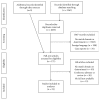A Proposal for an Intermediate Care Unit-Quality Measurement Framework
- PMID: 30151281
- PMCID: PMC6087599
- DOI: 10.1155/2018/4560718
A Proposal for an Intermediate Care Unit-Quality Measurement Framework
Abstract
Rationale, Aims, and Objectives. The Intermediate Care Unit (IMCU) is a hospital unit which is logistically situated between the hospital ward and the Intensive Care Unit (ICU). There is debate regarding the value of the IMCU. Understanding its value is compromised by the lack of adequate quality indicators. Therefore, this study identifies currently used IMCU indicators and evaluates their usefulness. Methods. Through a systematic literature search, currently used quality indicators were identified and evaluated for their importance using a proposed IMCU-specific quality measurement framework. Results. From 4034 titles and abstracts, 168 articles were selected for full-text review. Of these, 22 articles were included, which reported IMCU quality at the level of the IMCU (n = 12), the ICU (n = 5), both IMCU and ICU (n = 3) or hospital level (n = 2). At the IMCU, the IMCU mortality (n = 16), discharge-to-ICU rate (n = 7), in-hospital IMCU mortality (n = 7), and length of stay (n = 6) were most frequently reported. Three studies compared the effect of different structures of the IMCU on its utilization or hospital outcome. Conclusions. Current focus in IMCU quality research is towards measuring quality at the IMCU itself. Since the influence of the structure of IMCUs on its utilization and its effects on hospital outcome are only rarely investigated, attention should shift towards these important issues in further research. The proposed IMCU quality measurement framework can thereby serve as a helpful tool.
Figures



References
LinkOut - more resources
Full Text Sources
Other Literature Sources

